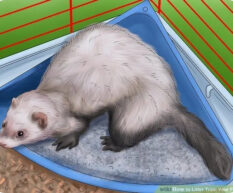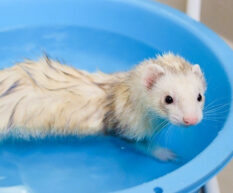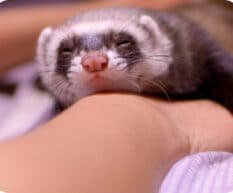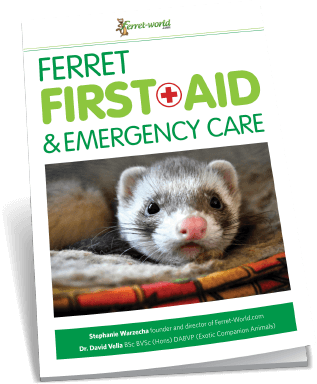Ferret News
Ferret Teething: Top 5 Unconventional Chewing Toys & What to Know About Your Fur-Baby’s Gnawing
By Jazmin "Sunny" Murphy
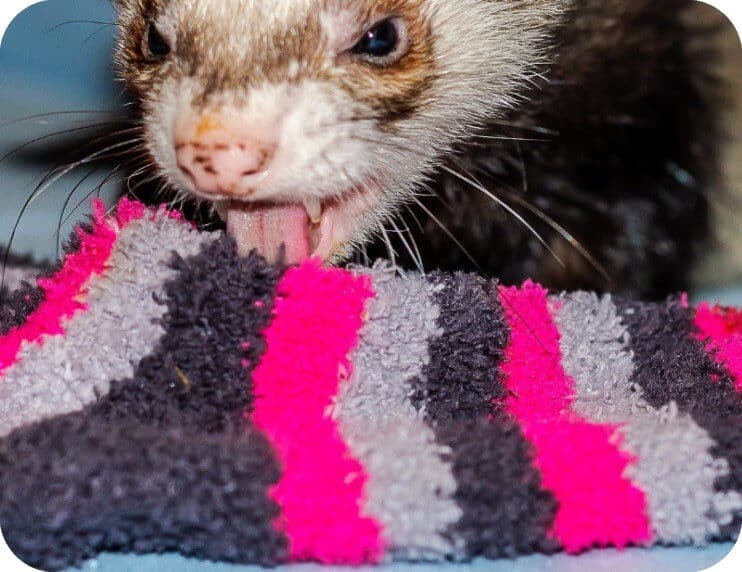
Ferrets can be voracious little things when they’re teething. It’s up to you to teach your fur-baby what’s appropriate to chew on and what’s not.
Your best bet at raising a ferret without too much biting is to provide the right toys to soothe those growing teeth. Yet, regular pet toys like Kong® balls and similar items aren’t great for teething ferrets.
Instead, these unconventional toys are ideal for soothing your young ferret’s discomfort, keeping those budding teeth clean, and supporting your little weasel’s overall health.
Top 5 chew toys for ferrets
Chew toys are a lifesaver for ferret owners. Whether you have a weeks-old kit struggling with painful teething or a high-energy weasel with an urge to chew, you can redirect those sharp teeth away from your fingers with the right playthings.
Plus, chew toys are a huge help in maintaining your ferret’s dental health. They’ll help:
- Fight tartar buildup
- Exercise your ferret’s jaw muscles
- Discourages hazardous behaviors like chewing on the cage
Yet, not all toys are made equal. Here are a few tips and recommendations to ensure you get the best ferret dental care for your buck.
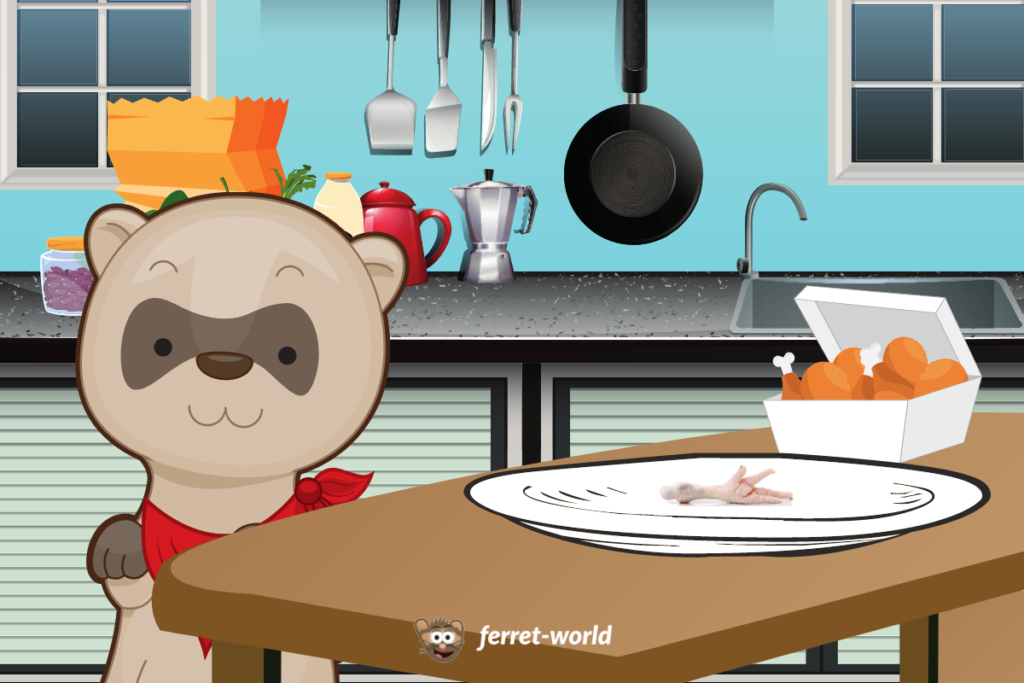
1. Dehydrated chicken feet
Using dehydrated foods to manage your ferret’s teething or biting habits is a bit controversial. While some think it’s the ideal, natural alternative to hazardous toys like those listed below, others say it’s a choking hazard.
Of course, this risk is much higher with younger, overeager ferrets that may bite off more than they can chew. For this reason, it’s best to restrict the use of dehydrated chicken feet as a chew toy to those times when you have time to supervise.
Yet, regardless of how you feel about dehydrated treats to quell your ferret’s chewing instinct, you must avoid “rawhide” treats. Although they’re often marketed as edible, “raw” treats, they are heavily processed and likely to cause blockages.
Pros
- A natural alternative to dangerous chew toys
- Provides healthy snack while reducing harmful chewing
Cons
- Some ferret owners say that this is a choking hazard
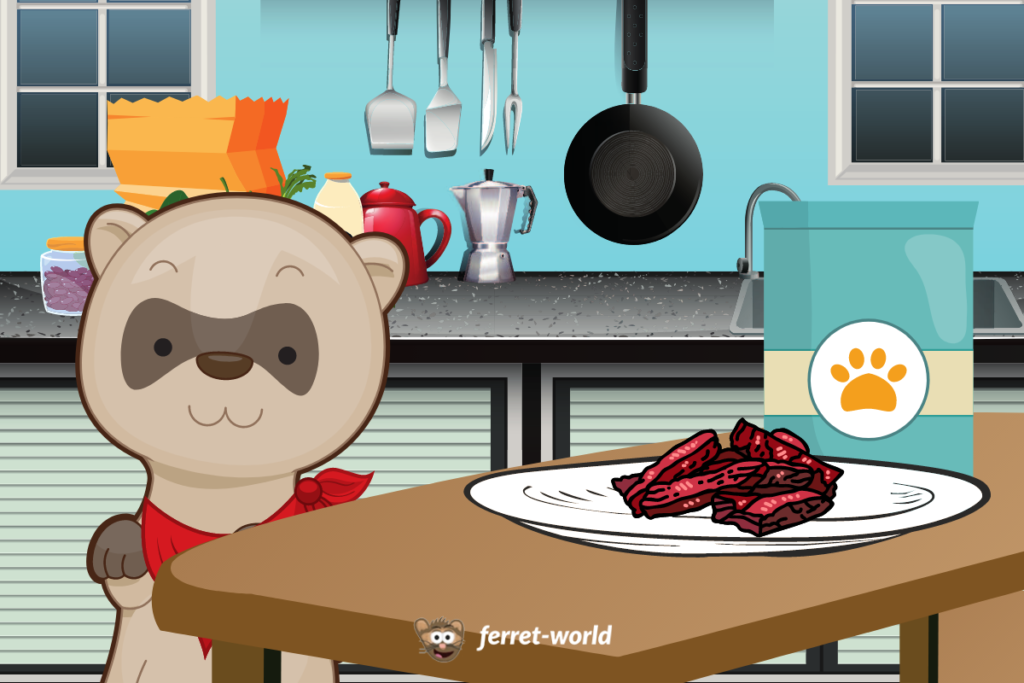
2. Ferret chew sticks
These are some of the most popular options for managing bad ferret chewing behaviors. They’re cheap, easy, and, of course, your ferret will love the tasty flavors!
One of the most highly rated ferret chews are the NBone salmon flavored treats. They’re excellent for removing tartar build-up, and have no artificial colors or flavors.
Plus, this treat is rich in taurine, which many ferret owners are familiar with due to its significance to cats, a close relative of ferrets. Ferrets on a raw, natural diet would get this nutrient from hearts, brains, and muscle. Otherwise, people may opt for powder supplements or treats like this, instead.
That said, if you’re looking for a multi-purpose chew toy that’ll keep your ferret busy and healthy, a chew stick is the best choice.
Pros
- Contains taurine, an essential nutrient for obligate carnivores
- Helps clean the teeth as your ferret chews
Cons
- Some brands may use artificial ingredients in the chew sticks
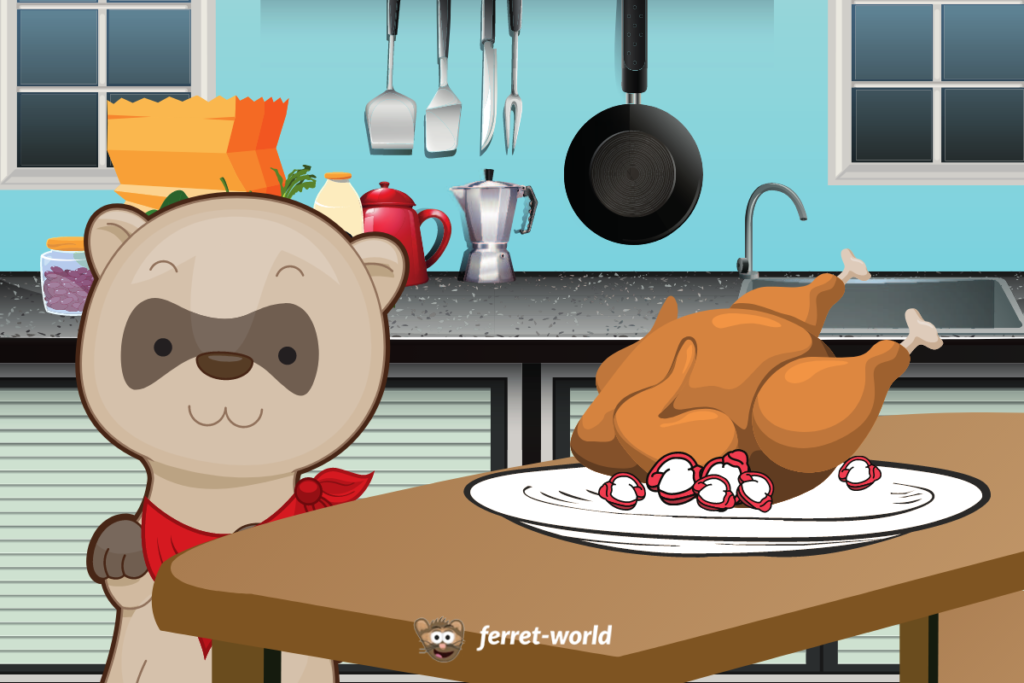
3. Gizzards
Gizzards are another highly popular choice among ferret owners with bite-happy weasels. Many have called it an excellent “organic toothbrush” (although it shouldn’t replace your actual dental care routine!). Plus, they make great chew toys that support jaw muscle strength.
You don’t have to settle for chicken when shopping for gizzards. Numerous ferret owners have had success with turkey and duck gizzards, too.
But why are they so beneficial for ferrets’ chewing? Well, gizzards are full of stones. Since birds don’t have teeth to chew things up like humans and their pets, the tiny rocks (known as “gastroliths”) break down food in the gizzard, enclosed by a thick wall of muscle.
They’re tough for ferrets to chew through, ensuring they stay busy with a mouth full of pearly whites.
Pros
- Highly effective at keeping ferrets’ teeth clean
- Provides a tasty snack while exercising jaw muscles
Cons
- Some ferrets take a while to appreciate gizzards
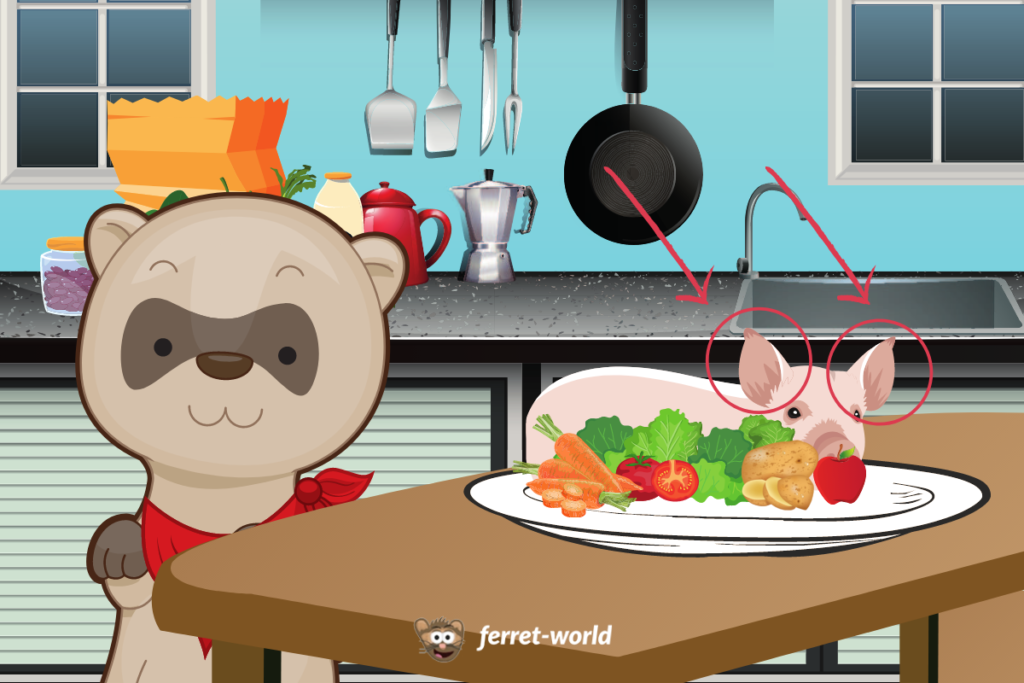
4. Pig ears
Using pig ears as a ferret chew toy is less common than other natural treats, as it’s another food that separates the community’s “schools of thought,” so to speak.
For instance, some swear by pig ears, saying they’ve helped reduce chewing on rubber items and even improved dental health. On the other hand, some ferret owners say that these can be fattening snacks and may contain artificial flavorings, so they’re best used sparingly.
Those who prefer to treat their ferrets with pig ears suggest that you serve them either rehydrated and dehydrated; both are fine. Which will work best depends on your ferret’s preferences.
Pros
- The tough cartilage makes a great alternative to rubber toys
- Makes a tasty treat for hungry ferrets
Cons
- Pig ear can be pretty fattening, so use it sparingly
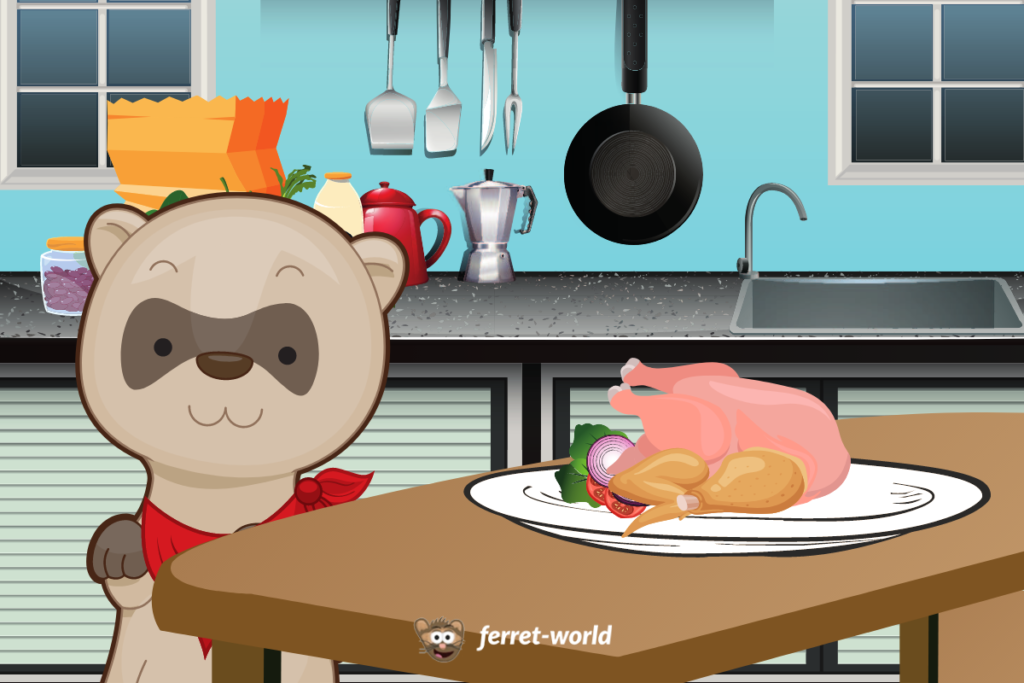
5. Chicken wing or thigh
A chicken wing or thigh is yet another unconventional toy that you need to be careful with. The idea of giving ferrets chicken wings may be controversial to some, as many worry about the potential of hollow bones snapping and causing internal injury or introducing a choking hazard.
If you want to try out chicken bones, make sure to supervise your ferret as it eats and prepare the chicken so that it is as safe as possible for eating and chewing.
For instance, you can cut off any sharp parts, and some ferret owners suggest removing the “knuckles” (joints), as they increase the choking risk.
Additionally, when serving wings, you can separate the three sections to make it easier for your ferret to handle. Some people even smash the bones to minimize the bone splintering risk, but this would negate the bones’ value as chewing toy alternatives.
Pros
- A tasty treat for ferrets
- Cheap, easy to find
Cons
- Depending on the preparation, it can present a choking risk
Toys to avoid when shopping for your teething ferret
Although there are many toys suitable for your ferret, not all are safe for those prone to chewing.
For instance, your fur-baby may love jumping around in a ball pit. However, a determined ferret can easily chew through the flimsy material and accidentally ingest the harmful plastic. So, these toys are best left for ferrets that have overcome their inappropriate chewing behaviors.
Additionally, although some ferret owners warn against buying Kong® and other rubber toys, they’re not necessarily unsafe for ferrets.
They’re not great for vigorous chewers, as they can be broken down with the right amount of persistence. But if your ferret simply needs something to nibble on now and then, you don’t have much to worry about. In either case, make sure it’s supervised.
Another kind of toy to be extra wary of is the stuffed animal. If your ferret rips the toy open, it may ingest materials like foam or fluff, which can cause intestinal blockages.
Since ferrets are prone to ripping their toys apart, it’s best to offer up something natural and safe to ingest, like those items listed above.
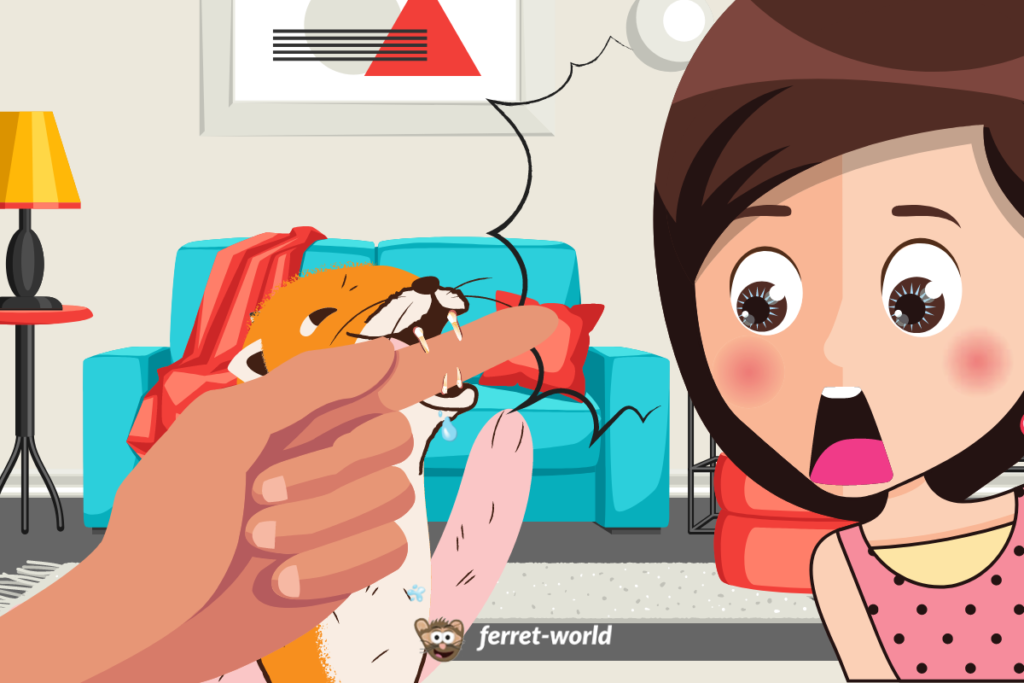
What to expect from teething ferrets
Baby ferrets about two to three months of age are known for teething because of their milk teeth. As the body replaces these baby teeth with adult ones, it causes pain and discomfort, leading the little weasel to pursue relief by gnawing on anything it can get its little claws on.
At this age, this strong need for chewing is guided by a critical lesson in youth known as “bite inhibition.”
As your ferret matures, it learns to control its bite force and be warier of others’ pain tolerance levels. This enhanced awareness supports greater safety during playtime, ensuring positive, pain-free interactions between you and your fur-baby.
You’ll play an active role in teaching your ferret proper bite inhibition, even as it attempts to soothe its aching teeth as a little kit. Of course, this means you’ll need to exercise a bit of patience as you play and know when to disengage to deter unwanted biting behaviors (tips below).
Generally, whether you’re having issues with problematic biting or not, know that the behavior can last as long as eight weeks, as this is the age at which your fur-baby develops its adult teeth.
Still, this doesn’t mean that you’re totally off the hook with bad biting after those new teeth come in. Some ferrets have been known to persist in such habits up to six months of age.
Yet, this behavioral pattern is largely tied to socialization, training, and enrichment. So, though it may sometimes feel like efforts to teach your ferret to stop biting are in vain, with persistence, the unwanted nips will stop.
When teething turns to biting (and how to stop it)
Sometimes ferrets can go a little too far with their rough play. Many pets, ferrets included, have tougher skin than humans, so they may not know when their bites are too much to handle.
That said, it may not occur to your ferret when it crosses the line of teething to biting. So, it’s your job to make that threshold clear.
Firstly, you’ll need to prepare a response to unwanted behavior. Do not physically punish or yell at your ferret. That will only create trauma and raise the risk of a bite injury, as your ferret would likely be frightened and try to protect itself.
As mentioned, ferrets usually develop all their adult teeth by eight weeks. Until then, it’s likely to deal with the pain and discomfort that leads to natural teething behavior.
However, if the problem persists, you can officially call it a “biting” issue that may become hazardous if it’s tied to aggression or a fear reaction. This can be more challenging to manage than teething; but with these tips, you’ll be prepared to stop it:
- Make a loud noise to show that you’re hurt. (Your goal is not to scare your ferret but to communicate that you’re injured.)
- Pull your hand or the area that was bitten away from your ferret.
- Ignore your ferret and don’t interact for about 3-5 minutes.
- Optional: Some ferret owners prefer to give their pets a time-out for naughty bites. For this, you’ll need an empty bin or playpen. The enclosure should be boring and separate from their sleep or play area to clarify that the area is for punishment. This option should only come after at least one round of Steps 1-3 if the ferret continues biting.
- Once your ferret has calmed down, you are free to reinitiate play.
- Repeat with each unwanted bite.
Remember, this will take lots of practice to eliminate unwanted biting. The best way to make sure things go smoothly is to avoid these critical training mistakes:
- Hitting: Many ferret owners are convinced that tapping or flicking a ferret on the nose or head is proper discipline. Yet, this only makes matters worse. Your pet’s likely to just nip you again in response. Plus, striking your ferret doesn’t teach it not to bite. Instead, flicks and smacks only condition it to expect physical force in response to its natural behaviors.
- Excessive time-out time: Be very careful with putting your ferret in timeout. Leaving it alone for too long can lead to frustration and emotional damage, as the ferret may forget why you isolated it after too much time. At that point, the punishment is no longer corrective, but cruel.
- Scruffing*: Some ferret owners recommend scruffing (grabbing your ferret by the extra skin on the back of its neck) for dealing with biting weasels, but it may not be a good idea. Often, scruffing just makes the problem worse, achieving the same effect as hitting.
*The only time scruffing may be acceptable is if your ferret latches on and it’s unresponsive to other corrective methods.

How to figure out why your ferret’s biting
One of the most important things to remember about welcoming your new baby weasel home is its natural inclination to chew. This urge is especially strong in kits that will likely nibble on your fingers and toes.
You can’t reasonably expect to do away with this habit entirely, but the proper toys and behavioral training will help minimize the injury risks.
Before you bring toys into the picture, ask yourself a few questions to identify the circumstances that will most likely cause your ferret to bite:
- How old is my ferret? The younger the ferret, the weaker its understanding of its strength and your sense of pain. Your fur-baby may not understand that your skin isn’t as tough, so you may need to work on signals or commands to curb excessive biting.
- Has my ferret eaten recently? A hungry ferret is a nippy one! One of the best things you can do to prevent unwanted nibbling is to make sure your ferret’s well-fed before playtime. Otherwise, it may be more aggressive and mouthy than usual.
- Note: It may be best to give your ferret one to three hours of rest after eating before playtime. Exercising your pet too soon after a meal may result in digestive problems.
- How is my ferret’s hearing? Ferrets that are hard of hearing may be jumpy during playtime, as they may not always hear you or another animal coming, causing them to be startled more easily, and more often. If you’re concerned about your ferret’s hearing, consult a veterinarian for guidance.
- Note: Researchers report a high prevalence of deafness in ferrets, especially those with “white-marked coats.” Of all the ferrets involved in a 2014 study on deafness and coat variations, “[a]ll panda, American panda, and blaze ferrets were deaf.”
- How is my ferret’s vision? Veterinary experts say that impaired vision is another reason why a ferret might bite more often, as it may be startled by sudden movements or touches. Albino ferrets have the highest chance of experiencing vision problems, so keep an eye on these pets and consult a veterinarian if you’re concerned for their sight.
Wrap-up: Nip your ferret’s chewing habit in the bud
You don’t have to settle for plain ol’ rubber chew toys for your teething ferret. It’s unlikely that they’ll help much.
Instead, things like chicken feet and gizzards are best for soothing dental pain and discomfort. If the problem persists, consider the possibility that it could be something much deeper, such as vision or hearing problems.
If you’re ever in doubt about your ferret’s health, concerning problematic chewing or other issues, consult your veterinarian to find a resolution.

